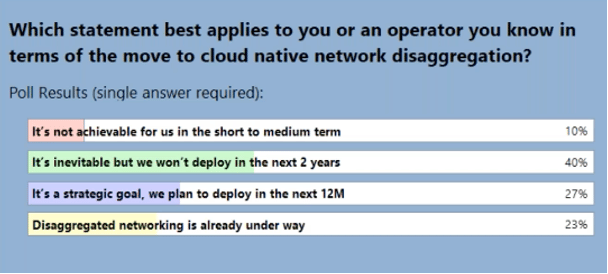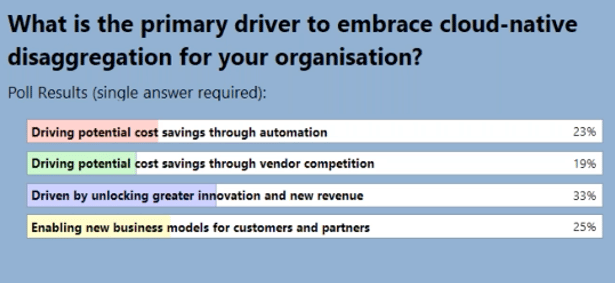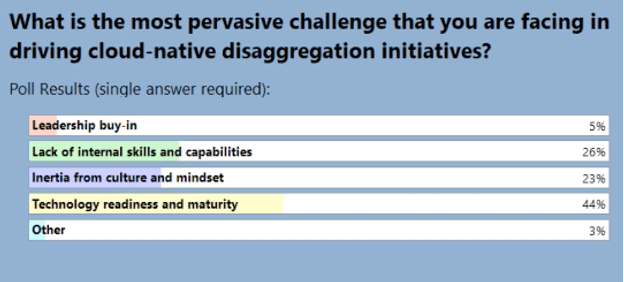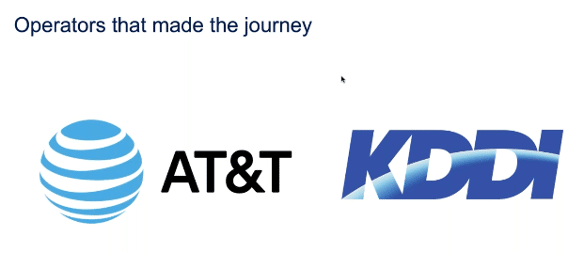It’s similar to today’s discussion on the electric/autonomous car. The vehicle won’t be used exclusively for short drives to and from your workplace or for pre-dictated path campus buses. Eventually, it will represent the world’s most popular means for ground transportation, and will carve out additional usage patterns as it evolves in parallel with people’s mindset.
After our recent joint webinar with STL Partners entitled “The road to cloud-native disaggregation: Do’s and don’ts from lessons learned,” I carved out another clear conclusion that brought me back to that disaggregation panel a decade ago. Disaggregation in networking is no longer a question of if, but when.
The move to cloud-native disaggregation
In the first part of the webinar, STL Partners discussed three key findings from a recent survey it had conducted.
- Disaggregation champions among service providers should invest in drawing management’s attention to the inevitable journey toward a safe haven; just like a lookout on the mast who directs the ship to land while everyone else is busy operating it.
- Disaggregation should be viewed beyond total cost of ownership (TCO), since that single perspective can be sidetracked by a one-time discount or by FUD (fear, uncertainty and doubt) instilled by alternative traditional solutions. Such a nearsighted perspective will lead to operators’ surviving (at best), but under no circumstances thriving, into the future.
- Service provider organizations should invest in education and prepare their internal teams to ensure a smooth and rapid adoption curve of new technology.
In other words, look at the big picture, onboard management, and gear up for the future.
As the webinar progressed, the STL Partners speakers presented their findings while requesting input from the audience. Given the 100+ people in attendance, I’d say their answers are as relevant as that of the survey.
When is disaggregation expected
The survey’s first question was when is disaggregation expected to take place in the organization. You can see the results below, but my take is that only 10% of the attendees believe disaggregation will occur more than 2 years from now. Considering that a network upgrade cycle takes about the same time, I’d say that 90% of service providers (attending the webinar) are already engaged with disaggregation for commercial purposes.
That’s 1-0 in favor of disaggregation (and my decade-old prediction…)

Why move to disaggregation
The second question was what are the operational benefits move to network disaggregation. The results favored innovation (~60%) over TCO (~40%), which is great news for operators who see the big picture – just as STL Partners concluded in its survey.
2-0 in favor of disaggregation

What challenges do operators face with disaggregation
The third question was what challenges do operators face with disaggregation. The results revealed a few conclusions. First, it’s clear that management doesn’t need to be onboarded; it’s already steering the ship in that direction. The other two responses, however, are far more interesting. About half of the respondents indicated that learning new skills and shifting their decades-old mindset of building traditional networks is an educational challenge. That means operators are eager to adopt disaggregation; their mindset is slowing them down, even though their eyes are set on the target. And the third takeaway? There’s a sense of doubt regarding the maturity of available disaggregated solutions.

How is DriveNets building networks like cloud
After the survey questions and results were presented, it was my turn. I did my part to describe how DriveNets builds networks like cloud that deliver TCO improvements and a path to fast innovation. I also explained how the architecture is built and pointed out the potential benefits for operators. However, after looking at the survey results from our great audience, I think my last slide was a slam dunk. I simply put two logos – AT&T and KDDI – side by side; both operators publicly talk about their disaggregation experience and the huge benefits their networks have achieved as a result.
My conclusion: whether maturity or technology readiness is a genuine worry or a slight scare, the answer is obvious.

White Paper
Which Network Architecture Is Right for You




